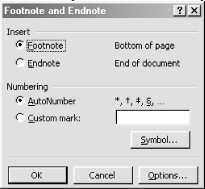Name
Insert → Footnote
Synopsis
Footnotes and endnotes typically contain supporting or explanatory information about text in a document. A superscript number appears next to the noted text, and that same number appears in front of the footnote or endnote. When noted text is deleted or moved and the new location changes the order of notes in the document, the numbers update automatically.
The only real difference between footnotes and endnotes is their location—footnotes appear at the foot of the page containing their relevant text, while endnotes are located at the end of the document. Use the Options dialog box to choose where endnotes appear. If a document is broken into sections, endnotes can appear at the end of the relevant section instead of at the end of the document.
Insert → Footnote opens the Footnote and Endnote dialog box (Figure 7-15), which is used to choose the type of note to insert, and whether or not Word should automatically number each note. In lieu of automatic numbering, a symbol, such as an asterisk, can appear on the noted text and before the footnote or endnote itself.

Figure 7-15. Inserting a footnote or endnote
It’s a good idea to let Word apply automatic numbering to footnotes and endnotes for the simple reason that things change. Moving and deleting text often moves and deletes notes as well. Word handles this automatically, updating note numbers to reflect ...
Get Word 2000 in a Nutshell now with the O’Reilly learning platform.
O’Reilly members experience books, live events, courses curated by job role, and more from O’Reilly and nearly 200 top publishers.

